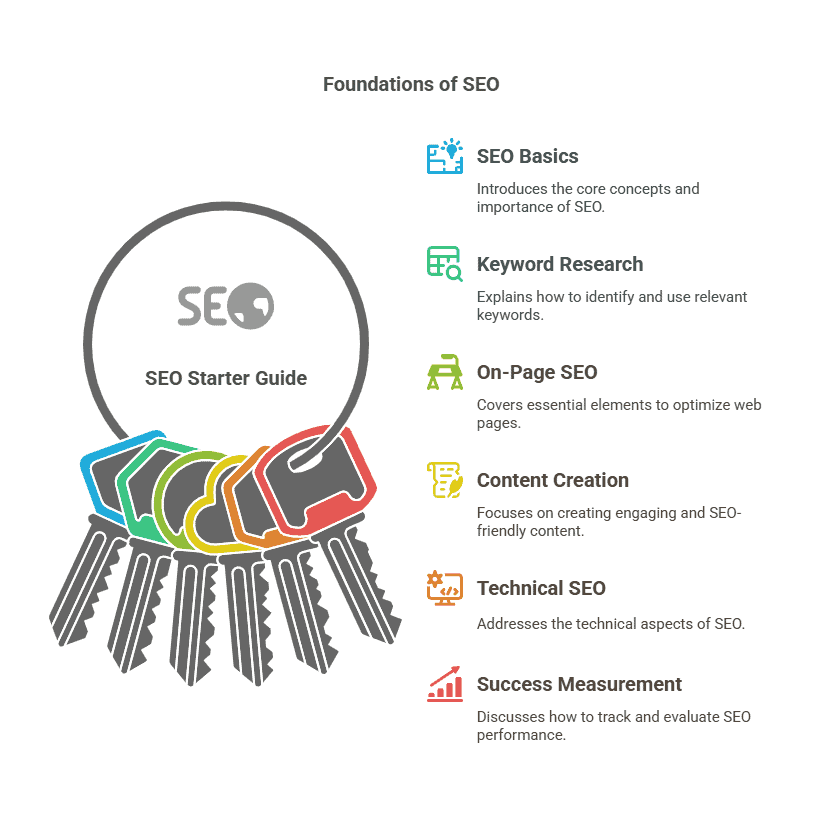Looking to boost your online presence? Learning the basics of search engine optimization is key. In this guide, I’ll cover the essential concepts to kickstart your journey.
Improving your website’s visibility on search engines can attract more visitors. This can also enhance your online reputation. For those aiming for a career in SEO, Write Remotely offer great job listings.
Key Takeaways
- Understanding the basics of search engine optimization
- Improving website visibility on search engines
- Resources for SEO-related job opportunities
- Essential concepts for beginners
- Boosting online credibility through optimization
What is SEO and Why It Matters
SEO is very important because it affects how visible a website is. We will explore what SEO is, its role in making websites more visible, and its benefits for businesses.
The Definition of Search Engine Optimization
SEO, or Search Engine Optimization, makes a website more visible to users. It involves knowing how search engines work and their ranking systems. SEO helps improve a website’s quality and traffic.
Key Terminology You Should Know
To fully understand SEO, knowing some key terms is essential. Important terms include:
- Keyword density: The percentage of times a keyword is used on a page.
- Meta tags: Small text descriptions that summarize a page’s content.
- Backlinks: Links from other websites to your website.
The Impact of SEO on Website Visibility
SEO greatly affects website visibility. By optimizing your site for search engines, you can attract more visitors. A well-optimized site can lead to more sales and conversions.
Business Benefits of Strong SEO
Strong SEO offers many benefits, such as:
- Increased website traffic
- Improved brand credibility
- Higher conversion rates
- Better return on investment (ROI) compared to other marketing
How Search Engines Work
It’s important to understand how search engines function to grasp SEO. Search engines use algorithms to crawl, index, and rank websites.
Crawling, Indexing, and Ranking Explained
The process involves three main steps:
- Crawling: Search engines discover new content through crawling.
- Indexing: The crawled content is then indexed, making it available for search.
- Ranking: When a user searches, the search engine ranks the indexed content based on relevance and quality.
For more information on SEO-related jobs, you can visit Write Remotely.

SEO Starter Guide: The Basics
Understanding SEO starts with knowing its core elements. We’ll explore the basics of SEO, focusing on what makes a good strategy. This includes learning about different SEO types and their roles in website optimization.
Core Components of SEO
SEO has several key parts that work together to boost a website’s search engine visibility. These parts form three main pillars.
The Three Pillars of SEO Success
- Technical SEO: This focuses on making a website easy for search engines to crawl and index.
- Content SEO: Creating high-quality, relevant content is key to attracting and keeping an audience.
- Off-page SEO: This includes strategies like link building and social signals that boost a website’s authority.
On-Page vs. Off-Page SEO
It’s important to know the difference between on-page and off-page SEO. On-page SEO deals with optimizing website elements like content and meta tags. Off-page SEO involves external factors like backlinks and social media presence.
When to Focus on Each Type
Start with on-page SEO to make sure your website is search engine-friendly. After that, use off-page SEO to increase your website’s visibility.
Technical vs. Content SEO
Technical SEO and content SEO go hand in hand. Technical SEO makes sure your website can be crawled and indexed. Content SEO focuses on the quality and relevance of your content.
Balancing Technical Elements with Quality Content
It’s all about balance. Make sure your website is technically sound, then create engaging content that speaks to your audience. For those interested in SEO, resources like Write Remotely offer job opportunities in the field.
Keyword Research Fundamentals
Keyword research is more than just finding keywords. It’s about understanding what users want. This is key to making content that people will find useful and to help your site show up in search results.
Understanding User Intent
User intent is why someone searches for something. It’s important to know if they want info, a specific site, or to buy something.
Informational, Navigational, and Commercial Keywords
Keywords can be grouped into three types based on user intent:
- Informational keywords: For when users are looking for info on a topic.
- Navigational keywords: When users want to find a specific website or page.
- Commercial keywords: For users ready to buy or engage in a transaction.
Tools for Keyword Research
To do good keyword research, you need the right tools. There are free and paid options out there.
Free and Paid Options for Beginners
Some top tools for keyword research are:
| Tool | Type | Features |
| Google Keyword Planner | Free | Basic keyword research, ad campaign planning |
| Ahrefs | Paid | Comprehensive keyword research, backlink analysis, content analysis |
| SEMrush | Paid | Keyword research, competitor analysis, technical SEO audit |
Analyzing Keyword Competition
Knowing who else is after your target keywords is key. It helps you spot chances that aren’t too crowded.
How to Find Low-Competition Opportunities
To find keywords with less competition, look for long-tail keywords. These are more specific phrases with lower search volumes. They’re often easier to rank for because they have less competition.
For more info on SEO jobs, check out Write Remotely.
On-Page SEO Essentials
Understanding on-page SEO is key to bettering your website’s ranking. You’ll learn how to tweak your site to boost its visibility and attract more visitors. On-page SEO includes important elements that help search engines grasp your content’s value.
Title Tags and Meta Descriptions
Title tags and meta descriptions are vital for on-page SEO. They give search engines a peek into your page’s content and purpose. A well-crafted title tag can significantly improve your page’s click-through rate.
Writing Compelling Tags That Rank
To craft effective title tags, include relevant keywords like “seo techniques for beginners.” Make sure they’re descriptive and brief. Meta descriptions should offer a clear summary, enticing users to click from search engine results. For more SEO job info, check out Write Remotely.
Header Tags and Content Structure
Header tags (H1, H2, H3, etc.) are key for organizing your content. A logical hierarchy of header tags can improve your content’s readability and SEO.
Creating a Logical Hierarchy
Begin with an H1 tag for the main title, then H2 tags for subheadings, and H3 tags for further subheadings. This structure aids search engines in understanding your content’s organization.
Image Optimization
Image optimization is a critical on-page SEO aspect. It involves making your images smaller to speed up page loading and adding context with alt text and file names.
Alt Text, File Names, and Compression
Use descriptive file names and alt text with target keywords, like “seo techniques for beginners.” Compressing images can greatly reduce their size, speeding up your page. This boosts user experience and search engine rankings.
Internal Linking Strategies
Internal linking is essential for search engines to grasp your website’s structure and content. A well-planned internal linking strategy can improve user experience and enhance your website’s SEO.
Building a Strong Site Architecture
To create a robust site architecture, establish a clear page hierarchy. Use internal linking to guide users and search engines through your content. This clarifies the relevance and importance of your pages.
Creating SEO-Friendly Content
Content is key in the world of search engine optimization. It must be high-quality, relevant, and well-structured. This section will cover the essential steps to make content that appeals to both users and search engines.
Quality Content Guidelines
To make effective content, follow some key guidelines. First, content should be informative and valuable to readers. It must be well-researched, accurate, and current. Also, it should be engaging, with a tone that’s both friendly and professional.
E-A-T: Expertise, Authoritativeness, Trustworthiness
Google’s E-A-T principles are vital for quality content. To show expertise, content creators should have deep knowledge of the topic. Authoritativeness comes from showing credentials and expertise. Trustworthiness is built through being transparent, accurate, and consistent.
Incorporating Keywords Naturally
Using relevant keywords is important for SEO-friendly content. But, it’s key to do it naturally and not force it. Conduct keyword research to find the right terms and phrases. Then, use them in a way that keeps the content easy to read.
Avoiding Keyword Stuffing
Keyword stuffing is a big mistake that can hurt your SEO. Avoid repeating keywords and instead use them naturally. Use different forms of the keyword, synonyms, and related phrases to achieve this.
Content Formatting Best Practices
How content is formatted greatly affects its readability and SEO. Using subheadings, lists, and white space makes content easier to scan and read. This improves the user experience and helps search engines understand the content’s structure.
Using Lists, Subheadings, and White Space
Lists, subheadings, and white space enhance content readability. For example, using
- or
- tags for lists makes content more scannable. Subheadings help create a clear structure, and white space prevents clutter, improving readability.
- For more information on SEO-related jobs, visit Write Remotely. By following these guidelines and best practices, you can create content that appeals to both users and search engines.
Technical SEO Basics
Technical SEO is often ignored, but it’s key for a good SEO plan. We’ll look at important areas that boost your site’s search engine ranking.
Site Speed Optimization
Site speed affects user experience and search rankings. A slow site can cause people to leave quickly.
Tools to Measure and Improve Loading Times
Use tools like Google PageSpeed Insights, GTmetrix, or Pingdom to check your site’s speed. They suggest ways to make it faster. Common tips include compressing images and minifying code.
Mobile-Friendliness
Most people use mobile devices to visit websites. So, making your site mobile-friendly is essential.
Responsive Design Principles
A responsive design works well on all devices. It uses flexible grids and media queries for a smooth experience.
URL Structure
A good URL structure helps users and search engines.
Creating Clean, Descriptive URLs
Use clear keywords and keep URLs short. For example, “example.com/seo-guide” is better than “example.com/page?id=123.”
XML Sitemaps
An XML sitemap helps search engines understand your site.
How to Create and Submit Your Sitemap
Make a sitemap with Google Search Console or plugins. Then, submit it to Google Search Console. For remote SEO jobs, check out Write Remotely.
Measuring SEO Success
SEO success is about how it affects your website’s rankings, traffic, and conversions. To see this impact, track and analyze important metrics. These show how well your SEO efforts are working.
Essential SEO Metrics
When checking SEO success, look at metrics that really matter. These are:
- Rankings: Watch your website’s spot for key words.
- Traffic: See how many visitors you get and what they do.
- Conversions: Follow what visitors do, like filling out forms or buying things.
Rankings, Traffic, and Conversions
These metrics are connected. For example, better rankings can mean more traffic. This can then lead to more conversions.
Using Google Analytics and Search Console
Google Analytics and Search Console are key for checking your SEO metrics.
Setting Up Your First Dashboard
To set up your dashboard, do this:
- Connect your Google Analytics and Search Console accounts.
- Make your dashboard show the most important SEO metrics.
Tracking and Adjusting Your Strategy
Checking your SEO metrics often helps you improve your strategy.
Monthly SEO Maintenance Tasks
- Check your keyword rankings and update your content.
- Look at traffic patterns and make your site better for users.
For more info on SEO jobs, check out Write Remotely.
Conclusion
Knowing the basics of SEO is key for any online presence. This guide has covered the essential elements to boost your website’s visibility and ranking on search engines.
By understanding the core of SEO, like keyword research, on-page optimization, and technical SEO, you’re on the right path. Keep learning and applying these principles to stay ahead in the digital world.
If you want to learn more about SEO or find jobs, check out Write Remotely. They offer SEO-related jobs and more guidance.
FAQ
What is the primary goal of Search Engine Optimization (SEO)?
SEO aims to boost your website’s traffic by ranking higher in search engines. This makes your site more visible and credible.
How does keyword research impact SEO?
Keyword research is key for SEO. It finds the search terms your audience uses. This lets you tailor your content to rank better in search results.
What is the difference between on-page and off-page SEO?
On-page SEO focuses on your website itself, like content and meta tags. Off-page SEO looks at external factors, like backlinks and social media, that affect your ranking.
Why is mobile-friendliness important for SEO?
Mobile-friendliness is critical because most searches are now mobile. Search engines like Google favor sites that work well on mobiles.
How can I measure the success of my SEO efforts?
Track metrics like rankings, traffic, and conversions with tools like Google Analytics. This shows how well your SEO is working and helps you improve.
What is the role of content quality in SEO?
Quality content is essential for SEO. It attracts and keeps your audience, showing expertise and trustworthiness. This boosts your site’s credibility and ranking.
How often should I perform SEO maintenance tasks?
Do SEO maintenance tasks regularly, like monthly. This keeps your site optimized and competitive.


 Owner of Write Remotely. Connecting businesses with talented writers and empowering remote work.
Owner of Write Remotely. Connecting businesses with talented writers and empowering remote work. 

